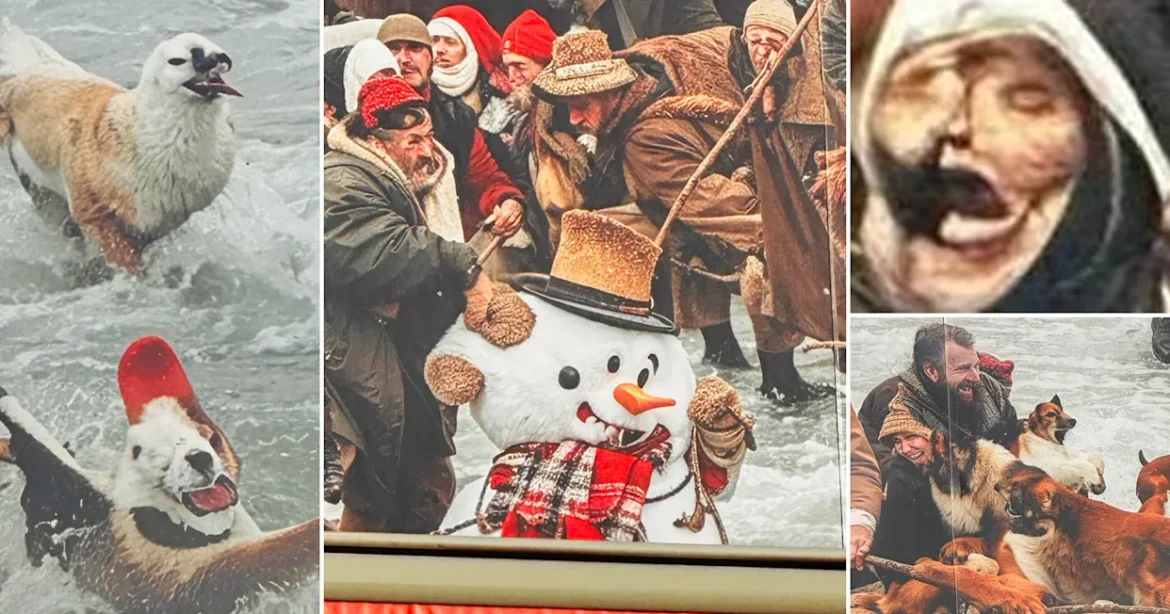Anyone strolling along a riverside path usually expects calming scenery or maybe a bit of festive cheer as the holidays approach.
But people wandering through Kingston’s riverside walk recently stopped in their tracks for a very different reason—a gigantic mural that looked cheerful from afar but deeply unsettling once you got close.
A Festive Scene That Quickly Turns Nightmarish
The artwork stretches across the wall above Côte Brasserie and other nearby restaurants, and at first glance, it resembles a lively Christmas celebration.
But once Londoners took a closer look, they realised something was very off.
The mural appears to be slapped together using AI, and the result is a collection of distorted faces, mangled animals, and surreal shapes that make no sense.
Social Media Reactions: Confusion Meets Comedy
It didn’t take long for baffled locals to drag the mural online.
One commenter on Reddit compared the scene to “Lovecraftian horror,” while another wondered how such “carnage” had ever been approved in the first place.
Someone else simply wrote, “So they didn’t even look at it once before printing it.”
Who Approved This? No One Seems to Know
The mural, which spans roughly 100 feet, sits above several restaurants along the popular Kingston Riverside Walk.
But surprisingly, no one has stepped forward to claim responsibility.
Côte Brasserie offered no comment, Bill’s hasn’t confirmed anything, and Kingston’s local council has not taken ownership either.
A source familiar with the situation suggested that the landlord of the area commissioned the mural without consulting the restaurants beneath it.
The Strange Imagery Hidden Within
Zooming into sections of the mural only raises more eyebrows.
One part shows dogs running through icy water—but their heads look like birds.
Another segment shows oddly shaped humans paddling a raft using what looks suspiciously like a dog’s leg.
And then there’s the chilling snowman with human-like eyes and teeth—an image many commenters said would haunt them for weeks.
Surprising, Considering AI’s Current Capabilities
What makes the mural even more bewildering is how advanced AI art tools have become.
Studies suggest most people can’t reliably tell AI-generated faces from real ones.
Yet this mural seems to come from the opposite end of the quality spectrum, leaving people questioning what kind of chaotic prompt produced such results.
Comments Swing Between Horror and Humor
Reactions online range from horrified to amused.
One person joked, “Nothing screams Christmas like a snowman with an eye on his cheek.”
Another asked if the prompt must have been “acid-trip for the holidays.”
Some residents were more frustrated than entertained, blasting the laziness of whoever approved such a bizarre piece.
Others insisted someone should have simply hired a real graphic designer.
Morbid Fascination Takes Over
Interestingly, not everyone hated it.
Some Londoners admitted they found the mural strangely captivating.
A few even said they planned to visit Kingston just to see the surreal spectacle in person.
One joked it gave them déjà vu from nightmares they’d had.
AI’s Awkward Holiday Moments Continue
This isn’t the first time AI has disrupted the festive mood.
Coca-Cola recently confirmed that its Christmas advert—traditionally a fan favourite—used AI for the second year in a row.
The backlash was immediate, with one viewer calling it “the best ad for Pepsi.”
A Bigger Fear: Elon Musk’s Longstanding Warnings About AI
While people laugh at the Kingston mural, Elon Musk has spent years warning that AI isn’t always a harmless experiment gone wrong.
Since 2014, he has called artificial intelligence humanity’s greatest existential threat, even comparing it to “summoning the demon.”
Musk claims his early investments in AI companies were meant to keep watch over the technology, not profit from it.
His main fear is that advanced AI could surpass humans—what experts call The Singularity.
Stephen Hawking Shared the Same Concern
Renowned physicist Stephen Hawking echoed similar fears, once saying full AI could “spell the end of the human race” as machines begin improving themselves faster than humans can keep up.
Musk’s Complicated Relationship With OpenAI
Despite these worries, Musk co-founded OpenAI with Sam Altman in hopes of keeping AI safe and widely accessible.
But things turned sour when he tried—and failed—to take control of the company in 2018.
He eventually walked away, and OpenAI went on to launch ChatGPT, which quickly took the world by storm.
Musk has since criticised the organisation, accusing it of straying from its original mission and becoming too controlled by major corporations.
Understanding the Singularity
The Singularity refers to a future moment when AI becomes more intelligent than humans and shapes the course of human evolution.
Some experts believe this could lead to harmonious human–machine collaboration, even allowing consciousness to be uploaded into computers.
Others warn of a darker future where AI dominates humanity.
Researchers are tracking signs of rapid AI progression, such as human-level speech translation or lightning-fast problem solving.
Futurist Ray Kurzweil predicts the Singularity may arrive as early as 2045—and his predictions are historically accurate.
What’s Next?
With public backlash growing over sloppy AI use—from chaotic murals to controversial adverts—society is now having a louder conversation about where artificial intelligence belongs in everyday life.
As tools become more advanced, the pressure increases for governments, companies, and creators to use AI more responsibly, set clearer standards, and ensure that technology enhances human experiences instead of replacing or distorting them.
Share on Facebook «||» Share on Twitter «||» Share on Reddit «||» Share on LinkedIn